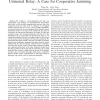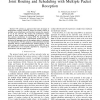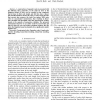225 search results - page 38 / 45 » Capacity Bounds for Sticky Channels |
GLOBECOM
2008
IEEE
14 years 1 months ago
2008
IEEE
—We consider a source-destination pair that can communicate only through an unauthenticated intermediate relay node. In this two-hop communication scenario, where the cooperation...
INFOCOM
2008
IEEE
14 years 1 months ago
2008
IEEE
— We present an approach that takes advantage of multi-packet reception (MPR) to reduce the negative effects of multiple access interference and therefore increase the capacity o...
CORR
2006
Springer
13 years 7 months ago
2006
Springer
A construction of expander codes is presented with the following three properties: (i) the codes lie close to the Singleton bound, (ii) they can be encoded in time complexity that ...
ICT
2004
Springer
14 years 23 days ago
2004
Springer
Array antennas have the potential to increase the capacity of wireless networks, but a distributed beamforming algorithm for maximizing the capacity in asynchronous, decentralized ...
CORR
2010
Springer
13 years 7 months ago
2010
Springer
A sender wishes to broadcast a message of length n over an alphabet of size k to r users, where each user i, 1 i r should be able to receive one of possible mi messages. The cha...



